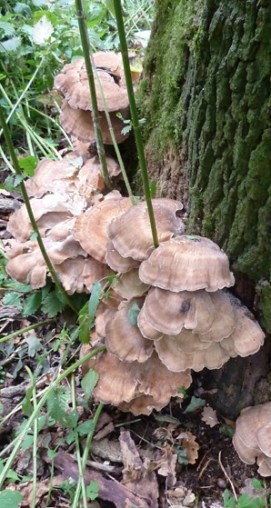A good year for Dryads Saddle – Best Bracket Fungus?
One of the most common bracket fungi found in the UK also happens to be one of the largest. And they’re out in force!
The beautiful Dryad’s Saddle or Pheasant Back Mushroom (Cerioporus squamosus) can put on some dazzling displays. They are often grouped in tiered columns on deciduous trees and stumps. They’re actually a parasite, causing severe white rot. Once the tree is dead they become saprobic and slowly begin to decompose the wood, that’s why you often find them on tree stumps.
This season in particular has been very good for these giant bracket fungus beauties. They fruit in spring and summer (sometimes into early autumn) and going by how many emails I’ve received about them this year, they are in plentiful numbers all over the UK.
Edible?
Oh yes! You can read more about this fascinating fungus on my previous post ‘Dry Saddle for the nymph!‘, albeit the featured specimens there were much older than those shown here, it actually is testament to how big they can get. Here you will also find the link for a simple but delicious recipe I discovered on YouTube. Definitely worth a go. Also check out the Forager Chef – Dryads Saddle, it covers some useful tips for preparation, recipes and preserving. Good stuff.
Dryad’s Saddle Gallery
Some of these great images here were kindly supplied by blog readers (click to view the full image). Many thanks to you all. Happy hunting…
QUICK ID TABLE: DRYAD’S SADDLE Cerioporus squamosus (Polyporus squamosus) |
CAP / FLESH 5-60cm across. Fan shaped. Top side is ochre/cream (maturing darker) with darker brown concentric fibrous scales. Flesh up to 4 or 5cm thick. White and succulent when young (tougher and dry when older). Strong ‘mealy’ smell. STEM 3-10cm x 6cm laterally attached (often off-centre) blackening towards the base. PORES / SPORE PRINT Very small (when young) getting larger with age, irregular and angular. White to Ochre/cream HABITAT / SEASON Parasitic then saprobic on deciduous trees and old stumps. EDIBILITY Edible and good when young and fresh. |
The Genus POLYPORUS & Related (Polypores): Characteristics to look out for: • Nearly all are bracket fungi, but a few are with typical cap and stem. They have pores (holes at the end of tubes in the flesh) instead of gills on the underside. |




 The Lumpy Bracket (Trametes gibbosa) is found in woodland exclusively growing on dead deciduous wood, of which it favours beech, often solitary but also can be found in medium to large groups (sometimes very large groups – see photographs below). Either way, most of the time it is a striking white colour (sometimes with hues of grey or buff) and very thick and lumpy.
The Lumpy Bracket (Trametes gibbosa) is found in woodland exclusively growing on dead deciduous wood, of which it favours beech, often solitary but also can be found in medium to large groups (sometimes very large groups – see photographs below). Either way, most of the time it is a striking white colour (sometimes with hues of grey or buff) and very thick and lumpy.
 What we have here is Turkeytail (trametes-versicolor) and is often layered in tiered groups on deciduous wood all year round. I often find these in ‘full bloom’ (so to speak) during the summer months. The pictures shown here are a selection from last June.
What we have here is Turkeytail (trametes-versicolor) and is often layered in tiered groups on deciduous wood all year round. I often find these in ‘full bloom’ (so to speak) during the summer months. The pictures shown here are a selection from last June.
 At the edge of a long woodland path in a Leicestershire wood, fortune was on my side when I came across Chicken of the Woods or Sulphur Polypore (Laetiporus sulphureus). One of those bracket fungi that are instantly recognisable and a joy to behold.
At the edge of a long woodland path in a Leicestershire wood, fortune was on my side when I came across Chicken of the Woods or Sulphur Polypore (Laetiporus sulphureus). One of those bracket fungi that are instantly recognisable and a joy to behold.

 Extremely common in our English woodlands, the Blushing Bracket (Daedaleopsis confragosa) is often found on the dead wood of Willow trees but also on many kinds of deciduous trees.
Extremely common in our English woodlands, the Blushing Bracket (Daedaleopsis confragosa) is often found on the dead wood of Willow trees but also on many kinds of deciduous trees.
 But many fungi are perennial and more noticeable through the winter months. They’re easier to spot since many trees are bare and no dense foliage can get in your line of sight. And although not edible, they are worth a look. Some have good uses or properties that are quite interesting (probably not everyday use), as you’ll soon discover…
But many fungi are perennial and more noticeable through the winter months. They’re easier to spot since many trees are bare and no dense foliage can get in your line of sight. And although not edible, they are worth a look. Some have good uses or properties that are quite interesting (probably not everyday use), as you’ll soon discover…

 This was indeed a Giant Polypore (Meripilus giganteus or Polyporus giganteus) occupying a good half of the tree’s circumference. Older parts on one side and younger ‘new’ born’ specimens emerging on the other.
This was indeed a Giant Polypore (Meripilus giganteus or Polyporus giganteus) occupying a good half of the tree’s circumference. Older parts on one side and younger ‘new’ born’ specimens emerging on the other.



